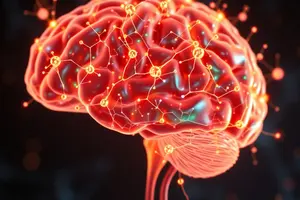Podcast
Questions and Answers
What is neuroplasticity?
What is neuroplasticity?
- The process of maintaining the static structure of neural networks in the brain
- The process of destroying neural networks in the brain and rebuilding them
- The inability of neural networks in the brain to change through growth and reorganization
- The ability of neural networks in the brain to change through growth and reorganization (correct)
Which form of neuroplasticity involves individual neuron pathways making new connections?
Which form of neuroplasticity involves individual neuron pathways making new connections?
- Homologous area adaptation (correct)
- Map expansion
- Cortical remapping
- Cross modal reassignment
When was it once thought by neuroscientists that neuroplasticity only manifests?
When was it once thought by neuroscientists that neuroplasticity only manifests?
- During childhood (correct)
- During adulthood
- During old age
- During adolescence
What type of plasticity exhibits a higher degree in the developing brain than the adult brain?
What type of plasticity exhibits a higher degree in the developing brain than the adult brain?
What can activity-dependent plasticity have significant implications for?
What can activity-dependent plasticity have significant implications for?
What results from learning a new ability, information acquisition, environmental influences, practice, and psychological stress?
What results from learning a new ability, information acquisition, environmental influences, practice, and psychological stress?
Which biological process is neuroplasticity based upon?
Which biological process is neuroplasticity based upon?
What is widely agreed upon as a result of a variety of pathways?
What is widely agreed upon as a result of a variety of pathways?
According to Christopher Shaw and Jill McEachern, what are the two types of neuroplasticity often discussed?
According to Christopher Shaw and Jill McEachern, what are the two types of neuroplasticity often discussed?
What is the core basis of neuroplasticity?
What is the core basis of neuroplasticity?
What was the substantial breakthrough observed by Merzenich and Woosley?
What was the substantial breakthrough observed by Merzenich and Woosley?
What factor allows for gene expression alterations leading to neuronal changes and thus neuroplasticity?
What factor allows for gene expression alterations leading to neuronal changes and thus neuroplasticity?
What allows for experience and neural activity to remodel brain function according to Merzenich's Kavli Prize citation?
What allows for experience and neural activity to remodel brain function according to Merzenich's Kavli Prize citation?
What happens at every level in the processing hierarchy, producing the map changes observed in the cerebral cortex according to JT Wall and J Xu?
What happens at every level in the processing hierarchy, producing the map changes observed in the cerebral cortex according to JT Wall and J Xu?
Who is credited as the first person to use the term 'neural plasticity'?
Who is credited as the first person to use the term 'neural plasticity'?
In what year did Michele Vicenzo Malacarne discover that the cerebellums of trained animals were larger than untrained animals?
In what year did Michele Vicenzo Malacarne discover that the cerebellums of trained animals were larger than untrained animals?
Who provided the first scientific evidence of anatomical brain plasticity in 1964?
Who provided the first scientific evidence of anatomical brain plasticity in 1964?
Who has been a pioneer in neuroplasticity research since the 1960s, making ambitious claims for its potential in treating various diseases and improving cognitive functioning in the elderly?
Who has been a pioneer in neuroplasticity research since the 1960s, making ambitious claims for its potential in treating various diseases and improving cognitive functioning in the elderly?
Who documented changes in hippocampal structure associated with acquiring knowledge in London taxi drivers in the 1990s?
Who documented changes in hippocampal structure associated with acquiring knowledge in London taxi drivers in the 1990s?
Who demonstrated changes in neuronal pathways in the 1920s, providing evidence of neuroplasticity?
Who demonstrated changes in neuronal pathways in the 1920s, providing evidence of neuroplasticity?
Who used the term neuronal plasticity in the early 1900s to describe nonpathological changes in adult brains?
Who used the term neuronal plasticity in the early 1900s to describe nonpathological changes in adult brains?
Who observed dynamic and adaptive properties in brain injuries in the 1940s and 1950s, suggesting neuroplasticity?
Who observed dynamic and adaptive properties in brain injuries in the 1940s and 1950s, suggesting neuroplasticity?
Who provided a sensory substitution device in the 1960s and conducted studies on stroke patients, providing evidence of neuroplasticity?
Who provided a sensory substitution device in the 1960s and conducted studies on stroke patients, providing evidence of neuroplasticity?
In which decade did David Hubel and Torsten Wiesel's experiments with kittens show that the brain associated with a ventilated eye was still active, contradicting the belief that it would be idle?
In which decade did David Hubel and Torsten Wiesel's experiments with kittens show that the brain associated with a ventilated eye was still active, contradicting the belief that it would be idle?
Flashcards are hidden until you start studying
Study Notes
- William James first used the term "plasticity" in psychology in 1890, describing a structure that can be influenced but not easily changed all at once.
- Jerzy Konorski is credited as the first person to use the term "neural plasticity" around 1900.
- Michele Vicenzo Malacarne discovered in 1793 that the cerebellums of trained animals were larger than untrained animals, suggesting neuroplasticity.
- Santiago Ramón y Cajal used the term neuronal plasticity in the early 1900s to describe nonpathological changes in adult brains.
- Karl Lashley's experiments in the 1920s demonstrated changes in neuronal pathways, providing evidence of neuroplasticity.
- Justo Gonzalo observed dynamic and adaptive properties in brain injuries in the 1940s and 1950s, suggesting neuroplasticity.
- Marian Diamond provided the first scientific evidence of anatomical brain plasticity in 1964.
- Paul Bach-y-Rita's sensory substitution device in the 1960s and studies on stroke patients provided further evidence of neuroplasticity.
- Eleanor Maguire documented changes in hippocampal structure associated with acquiring knowledge in London taxi drivers in the 1990s.
- Michael Merzenich has been a pioneer in neuroplasticity research since the 1960s, making ambitious claims for its potential in treating various diseases and improving cognitive functioning in the elderly.
- David Hubel and Torsten Wiesel's experiments with kittens in the 1960s showed that the brain associated with a ventilated eye was still active, contradicting the belief that it would be idle.
Studying That Suits You
Use AI to generate personalized quizzes and flashcards to suit your learning preferences.




